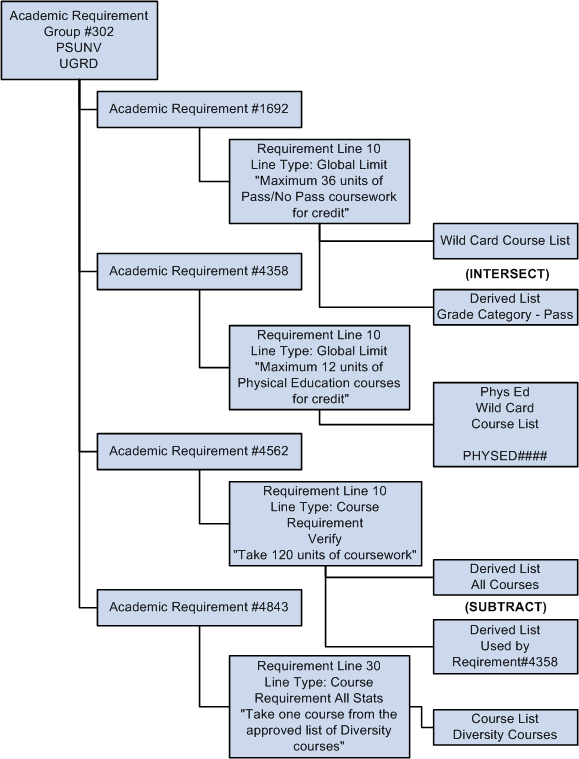 Setting Up a Local Sequential Restriction Requirement
Setting Up a Local Sequential Restriction Requirement
This appendix is a supplement to the general documentation on sequential restrictions, and provides examples and detailed instructions for setting up two types of sequential restriction requirements:
Local sequential restriction requirement.
Global sequential restriction requirement.
See Also
Creating a Requirement Line Item
 Setting Up a Local Sequential Restriction Requirement
Setting Up a Local Sequential Restriction Requirement
Local restriction requirements enforce course completion in a particular order, for a specific requirement group, requirement, or requirement line. With the use of more advanced derived lists, local sequential restriction requirements can also apply to a dynamically generated group of targets (such as all courses used by a particular plan). Unlike their global sequential restriction counterpart, local sequential restriction requirements have a specific target to which they apply.
Here's how to set up a simple local sequential restriction requirement:
Create an academic course list that includes the courses for which you want to control sequence. For example, Accounting 100a (course sequence 1), Accounting 100b (course sequence 2), and Accounting 200 (course sequence 3). Make sure that the course sequence value is assigned to the correct course on the Course Detail page.
Locate an existing All Stats academic requirement Line Item that requires these same courses. For example, the Accounting Minor requirement, which requires 18 units total, and points to a course list of many Accounting courses, in no particular order.
In the same requirement mentioned in step 2, add a second line item with a Line Type of Sequential Restriction.
Access the Line Item Detail page for line 20, and attach the special sequential restriction course list you created in step 1.
Save the requirement. By default, the target of your sequential restriction line item will be the current requirement. So, if you do not specify a target, you can save the requirement and simply attach it to a requirement group that applies to Accounting Minors.
The following diagram displays an overview of how to set up a local sequential restriction requirement.

Local sequential restriction requirement structure
 Setting Up a Global Sequential Restriction Requirement
Setting Up a Global Sequential Restriction Requirement
Global restriction requirements work to enforce that only those courses taken in a particular sequence can apply toward the advising report. Unlike their local sequential restriction counterpart, global sequential restriction requirements have no specified target (their default target is the entire audit), and they go into effect as soon as they are encountered by the advisement engine process (based on reporting sequence).
Reporting sequence and academic structure determine the order in which academic requirement groups are evaluated.
See Understanding Academic Requirement Groups.
Here's how to set up a global sequential restriction requirement:
Create an academic course list that includes the courses for which you want to globally control course sequence. For example, Spanish 100 (course sequence 1), Spanish 200 (course sequence 2), Spanish 300 (course sequence 3), and Spanish 330 (course sequence 4). Make sure that the course sequence value is assigned to the correct course on the Course Detail page.
Create an academic requirement that solely houses the sequential restriction, instead of attaching the sequential restriction as an additional requirement line (like you do for a local sequential restriction requirement). In the academic requirement, set the Line Type to Global Sequential Restriction on the Line Item page, then attach your course list on the Line Item Detail page. By setting up the sequential requirement as a separate requirement, you can reuse it across requirement groups at the institution (which is typically the case with global sequential restrictions).
Save the academic requirement, and attach it to the highest level requirement group for each group of students to whom you want this to apply. You can either attach it to a career level requirement group (so that it applies to all programs within the career), a program level requirement group (so that it applies to students in the programs that you specify), a plan level requirement group, or even a subplan level requirement group. What is important to note is that the system begins enforcing the global sequential restriction only when it is encountered by the advisement engine. Therefore, the higher you place the sequential restriction requirement, the sooner the system will "see" the requirement and begin enforcing it.
The following diagram displays an overview of how to set up a global sequential restriction requirement.

Global sequential restriction requirement structure